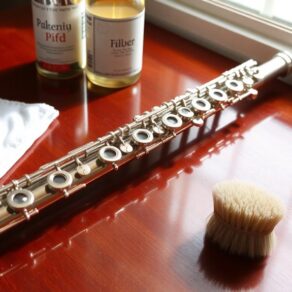Flute pads seal tone holes and are essential for sound quality. You should regularly check for signs of wear, like cracks or discoloration, which indicate it's time for replacement. Clean your pads after playing by swabbing the flute to remove moisture and using a soft cloth for gentle maintenance. When replacement is necessary, gather tools like a pad puller and new pads, ensuring you select the right material for your playing style, such as felt or synthetic. Following these tips can extend pad life and enhance performance. For detailed steps on replacement and material selection, keep going.
Key Takeaways
- Regularly inspect flute pads for visible damage, discoloration, or wear to ensure optimal performance and sound quality.
- Clean and dry pads after each use to prevent moisture buildup and prolong their lifespan.
- Replace worn pads promptly to avoid air leaks, sluggish keys, and changes in tone quality.
- Choose the right pad material based on your playing environment; felt for warmth, synthetic for durability.
- Follow proper replacement steps, including using the right tools and ensuring secure installation for effective sealing.
Understanding Flute Pads

Understanding flute pads is vital for maintaining the instrument's performance and longevity. Flute pads play an important role in sealing the tone holes, guaranteeing a clean sound and proper airflow.
When you explore flute pads, you'll encounter various pad types and materials, each with distinct characteristics that affect sound quality and durability. Common pad types include felt pads, which offer a softer feel but may wear out more quickly, and plastic pads, known for their resilience and moisture resistance.
Some musicians prefer felt pads for their warm tone, while others opt for plastic pads due to their longevity and reliability. Additionally, you'll find pads made from different materials, such as cardboard or metal, which further influence the pad's lifespan and performance.
Choosing the right pad materials is essential for your specific playing style and environmental conditions. For instance, if you frequently play in humid settings, moisture-resistant pads might be the best option for you. Regular maintenance and timely pad replacement are crucial to ensure your flute remains in optimal playing condition.
Signs Your Pads Need Replacement

Recognizing when your flute pads need replacement is essential for maintaining ideal sound and playability. One of the first signs of pad wear is visible damage, such as cracks, tears, or peeling. If you notice any of these issues, it's time to evaluate a replacement.
Additionally, if your pads are becoming discolored or compressed, it's a clear indication of reduced pad performance.
Another critical sign is the presence of leaks. You can test for leaks by closing the tone holes and blowing air through the flute. If air escapes, your pads may not be sealing properly, which can hinder sound quality.
Also, pay attention to how your flute feels while playing; if you experience difficulty in closing keys or if the keys feel sluggish, that's often a result of worn pads.
Finally, listen to your sound. If you notice a change in tone quality or an increase in resistance while playing, it may be due to failing pads. Regularly evaluating these signs will help you maintain your flute and guarantee it continues to deliver peak performance for years to come. Moreover, ensuring that you have the right essential flute key springs can also enhance pad function and prolong their lifespan.
Routine Care for Flute Pads

Your flute's pads require regular care to guarantee their longevity and peak performance. One of the most critical aspects of pad maintenance is ensuring they stay clean and dry. After each playing session, take a moment to swab out the inside of your flute. This helps remove moisture that can accumulate and compromise the pads' effectiveness.
For pad cleaning, consider using a soft, lint-free cloth to gently wipe the surface of the pads. Avoid using excessive force, as pads are delicate and can be easily damaged. If you notice any debris or buildup around the pads, use a small brush or a soft, dry cloth to carefully remove it.
It's also essential to regularly check for any signs of wear or damage. If you notice pads that feel sticky or don't seal properly, it's time to reassess your maintenance routine. High-quality pads are crucial for optimal performance, as they significantly impact sound production.
Always store your flute in a protective case to prevent exposure to dust and humidity. Following these simple steps will keep your pads in prime condition, ensuring your instrument plays beautifully for years to come.
How to Replace Flute Pads

Replacing flute pads is a precise task that can greatly enhance your instrument's performance. To guarantee successful pad replacement, follow these steps:
- Gather Your Tools: You'll need a pad puller, adhesive, new pads, and a tuning fork for adjustments.
- Remove Old Pads: Use the pad puller carefully to extract the old pads without damaging the tone holes. Inspect the pads for moisture damage.
- Clean the Surface: Make sure the tone holes are free of residue. A clean surface is essential for effective pad installation techniques.
- Install New Pads: Choose appropriate pads based on your pad materials comparison. Apply adhesive to the pad and place it securely over the tone hole. Allow it to set as per the manufacturer's recommendations. Regular maintenance, including cleaning kits, can help prevent moisture damage to pads and prolong their lifespan.
Choosing the Right Pads

When it comes to choosing the right pads for your flute, understanding the materials and characteristics of each option is vital.
Flute pads come in various pad materials, each offering unique benefits. Common choices include felt, cardboard, and synthetic materials. Felt pads provide good sealing properties but may absorb moisture over time. Synthetic pads, on the other hand, are more resistant to moisture and wear, making them ideal for humid conditions. Additionally, you might want to consider flute replacement crowns as they can enhance the overall performance and longevity of your instrument.
Next, consider pad sizes carefully. Each pad must fit snugly within the tone holes to guarantee peak sealing and sound quality.
It's important to measure your existing pads or consult your flute's specifications to select the correct sizes.
Frequently Asked Questions
Can I Use My Flute if One Pad Is Damaged?
If one pad is damaged, you can still use your flute, but it won't perform at its best.
The pad functionality is compromised, which may lead to air leaks and intonation issues.
While you might be tempted to try temporary fixes, they won't provide a lasting solution.
It's best to address the damaged pad promptly to maintain your instrument's integrity and sound quality.
Regular maintenance guarantees you enjoy your flute to its fullest potential.
How Long Do Flute Pads Typically Last?
Flute pads typically last between three to five years, depending on factors like usage and pad maintenance.
If you play frequently, you might notice wear sooner, so keeping an eye on their condition is essential.
Regular maintenance, such as cleaning and ensuring proper humidity levels, can extend a pad's lifespan.
What Materials Are Flute Pads Made From?
Flute pads are typically crafted from a combination of materials, ensuring durability and superior sound quality.
You'll find pad construction often includes felt, cardboard, and leather, each serving a specific function.
Various pad types, like resonator pads or synthetic options, cater to different playing styles and preferences.
Understanding these materials helps you choose the right pads for your flute, enhancing your performance and ensuring your instrument stays in peak condition.
Do Temperature Changes Affect Flute Pad Performance?
Yes, temperature fluctuations can greatly affect your flute pad performance.
When exposed to extreme temperatures, pads may lose durability, leading to issues like sticking or uneven sealing.
As you play, humidity and heat can cause the pads to expand or contract, impacting their fit against the tone holes.
To maintain ideal performance, store your flute in a stable environment and regularly check the pads for any signs of wear.
Can I Clean Flute Pads With Water?
You shouldn't clean flute pads with water, as it can damage the felt and adhesive.
Instead, consider using dry cleaning methods for proper pad maintenance. A soft brush or a microfiber cloth works well to remove dust and debris without introducing moisture.
Regular maintenance can enhance pad longevity and performance, ensuring your flute sounds its best.
Keeping your pads clean is essential for your instrument's overall health and your playing experience.
Conclusion
To sum up, caring for your flute pads is like tending to a delicate garden; with attention and proper maintenance, they'll flourish and enhance your playing experience. Regularly check for signs of wear and know when it's time for a replacement. By following these tips and choosing the right pads, you can guarantee your instrument stays in peak condition, allowing your music to resonate beautifully. Keep your flute singing, and it will reward you with every note you play.






